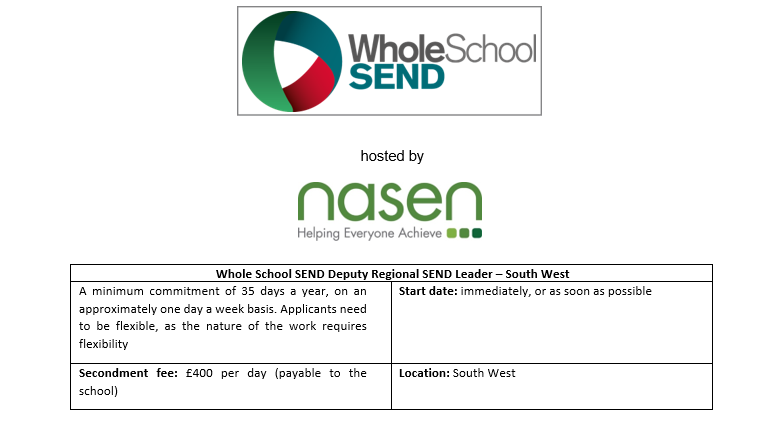|
26/5/2022 0 Comments Whole School SEND Professional Development Groups 2022 - 2023 - and a job opportunityWhole School SEND are now recruiting for an exciting opportunity to join eight tailored, regionally-based professional development groups funded by the Department for Education. “I must say it was one of the most purposeful and useful things I have been a part of in my professional career.” (2021-2022 PD group participant) Participants from the 2021 - 2022 programme were found, after completing the programme, to have:
Outcomes for children and young people with SEND continue to be below outcomes compared to those with no SEND; exclusion and absence rates are higher for those with SEND, and there is growing concern about the mental health and wellbeing of children and young people with SEND in particular. Improving SEND provision across all schools is key to improving all outcomes. To help tackle these issues, Whole School SEND is running a programme of regional professional development groups. The aim of these groups is to build a model of sector-led improvement that will support participants to undertake their own school-improvement project within their setting. This is an opportunity to access free, Department for Education-funded CPD with a proven record of success. Each group will be facilitated by a WSS Regional SEND Lead, but will be driven by its members, providing a space for peer-to-peer reflection, challenge and support. Participation is encouraged from school-based colleagues in all roles and across all school types, including colleagues from Further Education, and particularly those with an interest in leading projects within their schools. Participants are not required to have an established interest or background in SEND. Participants are particularly welcomed from under-represented groups as it is hoped that each group will include a broad range of experiences and perspectives to inform discussion. By joining these groups, participants commit to:
Each regional group will be loosely arranged around one of the themes below:
However, participants are encouraged to undertake a variety of projects and the discussions and aims of the group will be driven by its members. In return, participants will receive support in developing their projects from the experienced Regional SEND Team, as well as individual support tailored to their role, school and setting. Information Webinar To help schools decide whether to apply for a place, Whole School SEND will be hosting a short information webinar on Wednesday 8 June 2022 | from 1630 to 1645. It is recommended that the Headteacher and SENCO from your setting attend. You can, of course, register your interest for the project prior to this session, and webinar attendance is not a prerequisite for participation. Register your Interest If you wish to participate in the professional development groups, please complete the following online form by Tuesday 14 June 2022 | 0900. Please contact [email protected] if you require this document or the Expression of Interest Form in an alternative format. Join Whole School SEND Whole School SEND (“WSS”) Deputy Regional SEND Leader (South West) For more information see the job advert and specification here:
0 Comments
|
SWIFT News
|
SPONSORED BY
Join us, be a part of our SWIFT community |
© COPYRIGHT 2022 SOUTH WEST INSTITUTE FOR TEACHING SWIFT. ALL RIGHTS RESERVED | Website by brightblueC
VIEW OUR PRIVACY NOTICES | VIEW OUR COURSE T&CS
VIEW OUR PRIVACY NOTICES | VIEW OUR COURSE T&CS




 RSS Feed
RSS Feed





